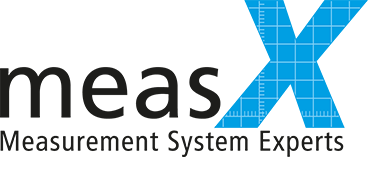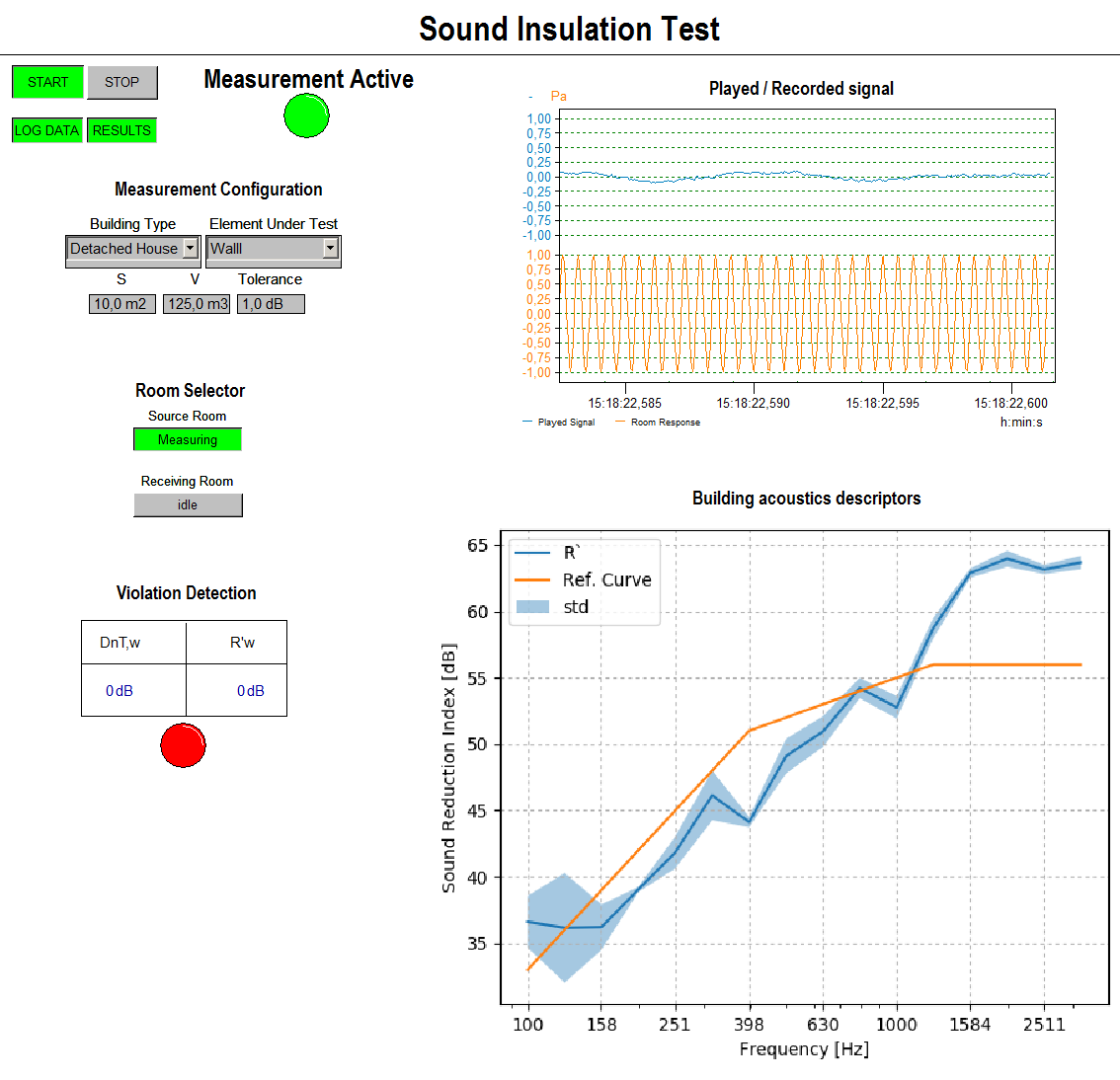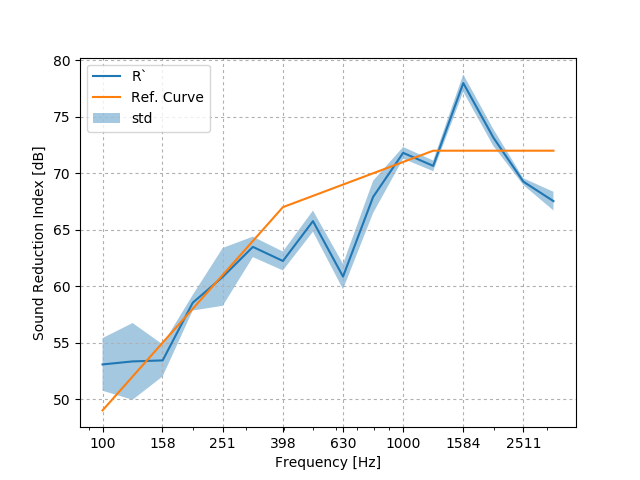Sound Insulation Tests based on DASYLab
Project: Master thesis by Boris Ndimubanzi in Computer Sience at the Hochschule Bonn-Rhein-Sieg
Area: Computer Science/ Autonomous Systems
Requirements: Sound Insulation Tests in Buildings
Implementation: Hardware:Microphone (PCB130E20); Data Acquisition: Measurement Computing (DT9832A) ; Software DASYLab
System for sound insulation tests in buildings based on DASYLab
In building acoustics, sound insulation is the ability of building structures to attenuate the level of sounds coming in or going out. This is an important property for the wellbeing and comfort of building occupants, therefore many countries have regulations defining desirable levels of sound insulation for different building types. It is then common to carry sound insulation tests to determine whether building structures conform to these regulations.
The testing consists of generating a test signal with known features, playing it through a loudspeaker, measuring the resulting sound field in test rooms on either side of building structures, and then calculating mainly two acoustic parameters: the Sound Pressure Level (SPL) and the reverberation time. From these parameters three descriptors can be derived to quantify the sound insulation capability of the building structure under test. There are many methods by which these descriptors can be derived, one of the most robust method being from the room impulse response measured in the test rooms. This method is more robust against noise and allows precise results even in conditions with poor Signal to Noise Ratio.
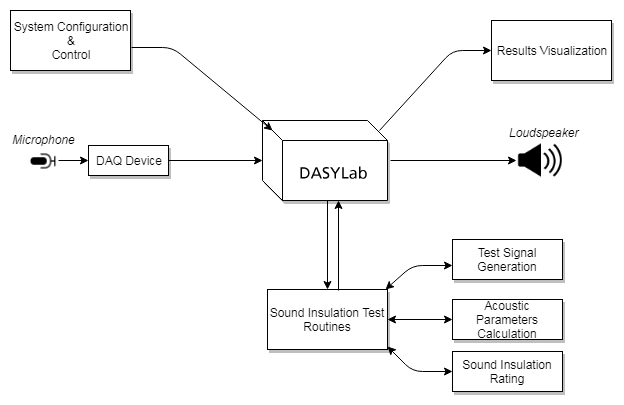 Figure 1: System components interconnectionThis system for sound insulation tests in buildings has three main components which need to interact together: the I/O devices, to acquire and output data, an analysis component, to generate test signals and process the acquired data to derive sound insulation descriptors, and a user interface, to control the system and visualize the analysis results. Implementing each of these components, and integrating them so that they interact with each other would normally require a lot of development resources. DASYLab is used to simplify the implementation and integration of these components. With little to no efforts DASYLab allows to integrate and interact with he I/O devices thanks to its configurable drag and drop modules for a number of major data acquisition devices. With its Python interface,DASYLab facilitates the exchange of data to and from the analysis component which is implemented in Python to benefit from powerful Python libraries like NumPy and SciPy for numerical analyses. DASYLab also provides an easy way to create and customize a GUI with its configurable inbuilt drag and drop displays and controls. The system is illustrated in Figure 1.
Figure 1: System components interconnectionThis system for sound insulation tests in buildings has three main components which need to interact together: the I/O devices, to acquire and output data, an analysis component, to generate test signals and process the acquired data to derive sound insulation descriptors, and a user interface, to control the system and visualize the analysis results. Implementing each of these components, and integrating them so that they interact with each other would normally require a lot of development resources. DASYLab is used to simplify the implementation and integration of these components. With little to no efforts DASYLab allows to integrate and interact with he I/O devices thanks to its configurable drag and drop modules for a number of major data acquisition devices. With its Python interface,DASYLab facilitates the exchange of data to and from the analysis component which is implemented in Python to benefit from powerful Python libraries like NumPy and SciPy for numerical analyses. DASYLab also provides an easy way to create and customize a GUI with its configurable inbuilt drag and drop displays and controls. The system is illustrated in Figure 1.
Figure 2 shows the standard setup for sound insulation tests in buildings.
System Description
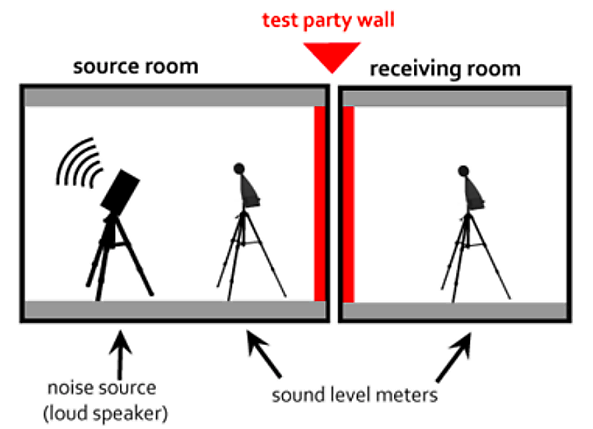 Figure 2: Standard sound insulation test setupThe system consists of a DT9832A data acquisition device, a PCB130E20 class 2 microphone, a Bluetooth loudspeaker, and a dodecahedron loudspeaker. DASYLab allows the acquisition of microphone data through its inbuilt DT9832A driver, and the output of the generated test signal to the loudspeaker through its soundcard driver.
Figure 2: Standard sound insulation test setupThe system consists of a DT9832A data acquisition device, a PCB130E20 class 2 microphone, a Bluetooth loudspeaker, and a dodecahedron loudspeaker. DASYLab allows the acquisition of microphone data through its inbuilt DT9832A driver, and the output of the generated test signal to the loudspeaker through its soundcard driver.
Sound insulation analysis
The implemented analysis method derives sound insulation descriptors from the room impulse response measured in the test rooms as per theISO 18233. To measure the room impulse response, the Exponential Sine Sweep approach is used, which is based on generating and playing an exponential sine sweep signal into a room [1]. An exponential sine sweep is a sine signal with a constant amplitude but with a frequency that varies exponentially. To measure the room impulse response, the response of the room to the played exponential sine sweep is recorded and convolved with an inverse filter which is a time reversed copy of the exponential sine sweep to which an amplitude modulation is applied.
With a sound source placed in the source room,the room impulse response is measured both in the source room and the receiving room, and from the measured impulse responses the SPL difference spectra between the two rooms and their respective reverberation times are derived.
The SPL difference between the two rooms andtheir reverberation time spectra are used to calculate the sound insulation descriptors, which are spectra quantifying the sound insulation performance at different frequencies. There are three building acoustics descriptors defined by the ISO 16283: the sound reduction index (R'), the normalized sound level difference (Dn), and the standardized sound level difference (DnT). They are given by the following equations:
R'=D+10log(S/A)
Dn=D+10log(A/A0)
DnT=D-10log(T/T0)
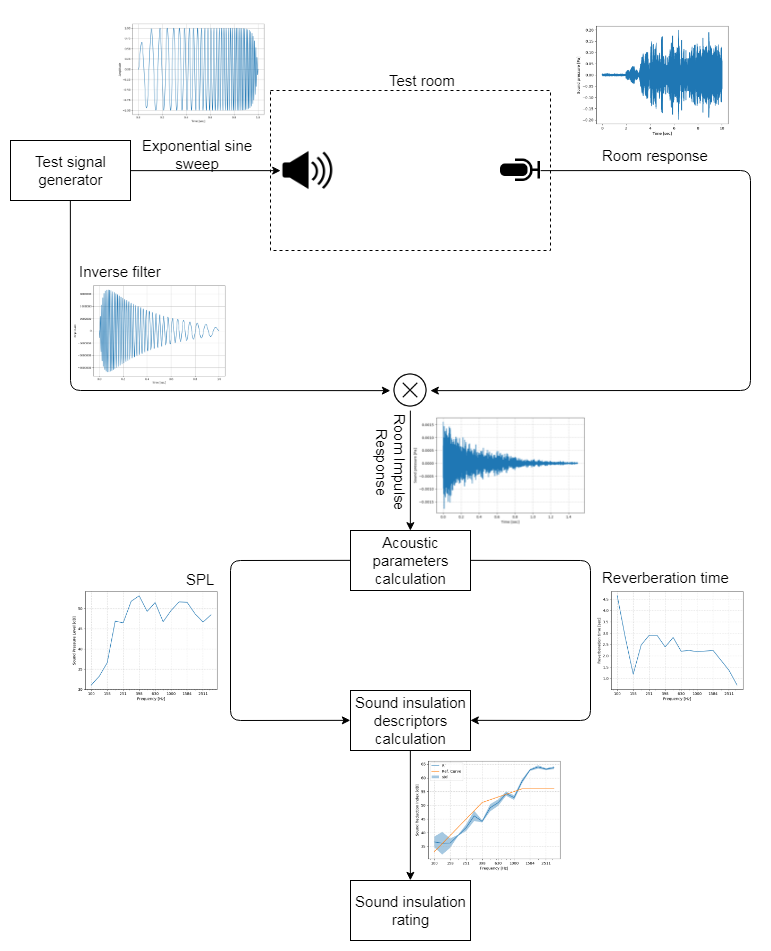 Figure 3: Sound insulation analysis pipelineWhere D is the SPL difference between the source and receiving rooms, S is the area of the common partition between the two rooms, A and A0 are the calculated and reference absorption areas of the receiving room, T and T0 are the calculated and reference reverberation timeTo rate the sound insulation performance of building structures, the above descriptors are converted to single numbers as per the ISO 717. The calculated sound insulation rating is then compared with the nominal rating defined by regulations in order to determine whether there is a violation of regulations or not. Figure 3 illustrates the pipeline of the analysis component of the system along with the corresponding intermediate results.
Figure 3: Sound insulation analysis pipelineWhere D is the SPL difference between the source and receiving rooms, S is the area of the common partition between the two rooms, A and A0 are the calculated and reference absorption areas of the receiving room, T and T0 are the calculated and reference reverberation timeTo rate the sound insulation performance of building structures, the above descriptors are converted to single numbers as per the ISO 717. The calculated sound insulation rating is then compared with the nominal rating defined by regulations in order to determine whether there is a violation of regulations or not. Figure 3 illustrates the pipeline of the analysis component of the system along with the corresponding intermediate results.
User Interface
DASYLab is used to create a GUI for configuring, controlling, and visualizing the sound insulation test results. The created GUI is illustrated in Figure 4.
Experimental Setup
The main result of the system is the calculation of the single numbers to rate the sound insulation performance of the building structure under test, and the comparison of the calculated ratings to the nominal ratings specified in building acoustics regulation. Figure 3 Sound insulation analysis pipeline This comparison between the calculated and the expected rating allows to detect violations of building acoustics regulations. It is possible to further analyze the measured data and the calculated descriptors in order to not only detect violations, but to also diagnose the potential causes behind the violations. An experiment was carried aiming to study the effect that slots and holes made on building’s structures to fit electric appliances have on the sound insulation performance. For a slot made in a wall to fit a lamp, the sound insulation descriptors were calculated for three scenarios:
- when the slot is empty
- when the slot is fitted with a lamp
- and when the slot is filled with concrete
The calculated building acoustics descriptors and the ratings of the sound insulation performance for each of these scenarios is illustrated in Figure 5, 6, and 7. In case of regulations violations, the
calculated building acoustics descriptors could be used to further classify and diagnose the types of defects in the building structure under test.
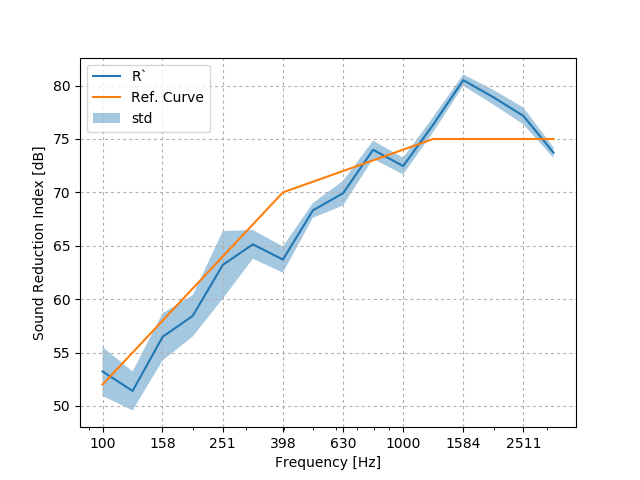
Figure 6: slot is fitted with a lamp
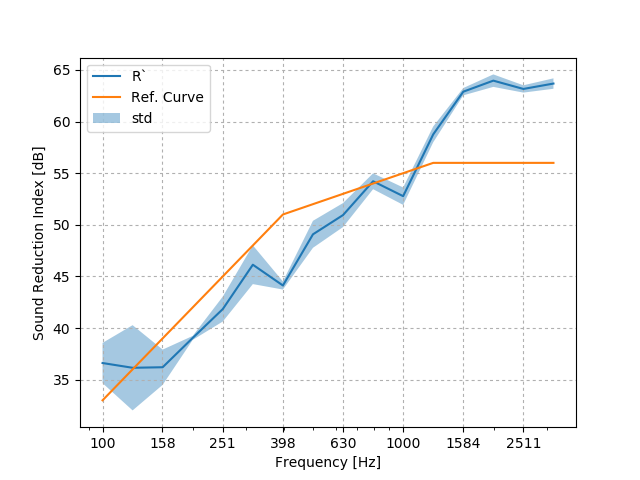
Figure 7: slot is filled with concrete
Conclusion
This application note described a system for testing sound insulation performance of buildings structures, highlighting how DASYLab was used to simplify its implementation by enabling an easy integration and development of its different components. DASYLab enables an out of the box interfacing with the DT9832A used for the acquisition of the PCB130E20 microphone data. DASYLab enables an easy interfacing with the analysis components implemented in Python, thus taking profit of a number of powerful Python libraries. Finally DASYLab allows to easily develop a GUI to interact with the system and visualize the results.Referenzen:
[1] A. Farina, „Simultaneous measurement of impulse response and distortion with a swept-sine technique,“ in Audio Engineering Society Convention 108, 2000.


